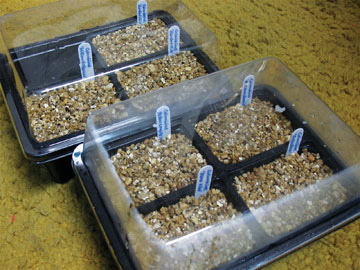|
NEWS NOTES
Mineral resource of the month: vermiculite
 Copyright Joel Ignacio |
| Vermiculite is used for plant propagation indoors. |
Michael J. Potter, mineral commodity specialist for the U.S. Geological Survey, prepared the following information on vermiculite, which is used in construction and horticulture.
Vermiculite, a hydrated magnesium-aluminum-iron silicate mineral, has a range of uses that take advantage of its fire resistance, good insulating properties, high liquid absorption capacity, inertness and low density. Most applications for vermiculite use an exfoliated (heat-expanded) form of the mineral. In general, coarser grades of vermiculite are used as loose fill insulation and in horticulture. Finer grades are used in wallboard and plasters and for animal feeds and fertilizers.
Deposits of vermiculite are generally associated with volcanic ultramafic rocks that are rich in magnesium silicate minerals. Vermiculite is a secondary mineral formed primarily by the alteration of mica and less commonly by the alteration of amphibole, chlorite, olivine, pyroxene or other clay minerals. Flakes of raw vermiculite are mica-like in appearance and contain water molecules in their chemical structures. When the flakes are heated rapidly at a temperature of 900 degrees Celsius or higher, the water flashes into steam and the flakes expand into accordion-like particles. The mineral’s color, which can range from black and various shades of brown to yellow for the raw flakes, changes upon expansion to gold or bronze. This expansion process is called exfoliation, and the resulting lightweight material is chemically inert, fire resistant and odorless.
Vermiculite is used in general building plasters, either on its own or in combination with other lightweight aggregates such as perlite. Special plasters include fire protection and acoustic products. Exfoliated vermiculite, sometimes treated with a water repellent, is used to fill pores and cavities in masonry construction and hollow blockwork to enhance acoustic, fire rating and insulation performance. Finer grades of exfoliated vermiculite, combined with potassium or sodium silicate, are used to produce insulation shapes.
In horticulture, exfoliated vermiculite improves soil aeration and moisture retention. When vermiculite is mixed with peat or other composted materials, such as pine bark, the resulting product provides a good growing medium for plants and helps them to propagate. As a soil conditioner, exfoliated vermiculite can improve the aeration of “sticky” soils (containing clay) and the water-holding characteristics of sandy soils. This allows for easier watering and reduces the likelihood of compaction, cracking and crusting of the soil.
Exfoliated vermiculite is also combined with high alumina (also known as calcium aluminate) cements and other aggregates such as clay, expanded shale and slate to produce refractory/insulation concretes and mortars. It can also be used in high-temperature coatings or binders for construction materials, gaskets, specialty papers and textiles, or to partially replace asbestos in brake linings for cars.
South Africa has been the leading producer of vermiculite concentrate since 1990, producing about 200,000 metric tons in 2006. Although official data were not available, China is thought to have an annual vermiculite output of at least 100,000 metric tons. The United States has produced an estimated 100,000 metric tons per year in recent years, primarily from operations in South Carolina and Virginia. Other producers include Australia, Brazil, Canada, Russia, Uganda and Zimbabwe. World production was an estimated 520,000 metric tons in 2006. U.S. reserves of vermiculite are estimated to be 25 million metric tons.
For more information on vermiculite and other mineral resources, visit: minerals.usgs.gov/minerals.

 Subscribe
Subscribe


